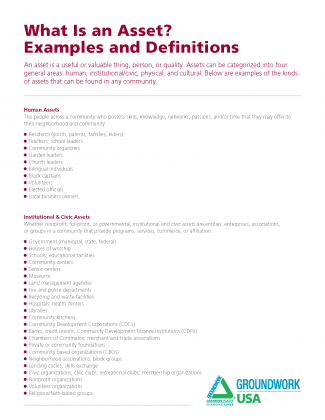Assets can take many forms. In communities, the most typically encountered types of assets are human, institutional and civic, physical, and cultural.
Download “What is an Asset? Examples and Definitions” which offers definitions and tangible examples of each type of asset found in any community.
Human Assets
The people across a community who possess skills, knowledge, networks, passions, and/or time that they may offer to their neighborhood and community. Examples include:
- Residents (youth, parents, families, elders)
- Teachers; school leaders
- Community organizers
- Garden leaders
- Church leaders
- Bilingual individuals
- Block captains
- Volunteers
- Elected officials
- Local business owners
Institutional and Civic Assets
Whether nonprofit, for-profit, or governmental, institutional and civic assets are entities, enterprises, associations, or groups in a community that provide programs, services, commerce, or affiliation. Examples include:
- Government (municipal, state, federal)
- Houses of worship
- Schools; educational facilities
- Community centers
- Senior centers
- Museums
- Land management agencies
- Fire and police departments
- Recycling and waste facilities
- Hospitals; health centers
- Library
- Community kitchen
- Community Development Corporations (CDCs)
- Banks, credit unions, Community Development Finance Institutions (CDFIs)
- Chambers of Commerce; merchant and trade associations
- Private or community foundations
- Community based organizations (CBOs)
- Neighborhood associations; block groups
- Lending circles, skills exchange
- Civic organizations, civic clubs, recreational clubs; membership organizations
- Nonprofit organizations
- Volunteer organizations
- Religious/faith-based groups
Physical Assets
Physical assets in a community can take shape as places, spaces, or structures. Examples include:
- Agricultural land and resources
- Natural resources (forests, lakes, ponds, streams, beaches, ocean)
- Landmarks (historical, cultural, architectural)
- Parks, open spaces, trails, community gardens, playgrounds, and recreational fields
- Civil infrastructure (bridges, streets, sewer and water facilities, streetlights)
- Vacant land
- Brownfield (contaminated) sites
- Industrial parks
Cultural Assets
Cultural assets are the arts, music, language, traditions, stories, and histories that make up a community’s identity, character, and customs. Examples include:
- Affinity groups and clubs
- Ethnic, racial, and religious diversity
- Historical resources
- Artist collaborative; arts programming
- Heritage crafts, skills, cultural traditions
- Festivals, fairs, cultural celebrations, lecture series, open mics
- Church/religious ceremonies, holidays, and observances

